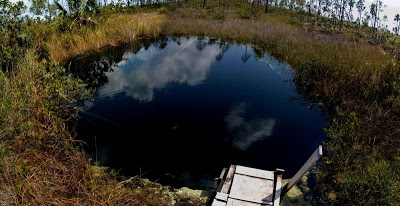
Discoveries made in some underwater caves by Texas &M University at Galveston researchers in the Bahamas could provide clues about how ocean life formed on Earth millions of years ago, and perhaps give hints of what types of marine life could be found on distant planets and moons.
Tom Iliffe, professor of marine biology at the Texas A&M-Galveston campus, and graduate student Brett Gonzalez of Trabuco Canyon, Calif., examined three “blue holes” in the Bahamas and found that layers of bacterial microbes exists in all three, but each cave had specialized forms of such life and at different depths, suggesting that microbial life in such caves is continually adapting to changes in available light, water chemistry and food sources. Their work, also done in conjunction with researchers from Penn State University, has been published in Hydrobiologia.
“Blue holes” are so named because from an aerial view, they appear circular in shape with different shades of blue in and around their entrances. There are estimated to be more than 1,000 such caves in the Bahamas, the largest concentration of blue holes in the world.
‘We examined two caves on Abaco Island and one on Andros Island,” Iliffe explains. “One on Abaco, at a depth of about 100 feet, had sheets of bacteria that were attached to the walls of the caves, almost one inch thick. Another cave on the same island had bacteria living within poisonous clouds of hydrogen sulfide at the boundary between fresh and salt water. These caves had different forms of bacteria, with the types and density changing as the light source from above grew dimmer and dimmer.
“In the cave on Andros, we expected to find something similar, but the hydrogen sulfide layer there contained different types of bacteria,” he adds. “It shows that the caves tend to have life forms that adapt to that particular habitat, and we found that some types of the bacteria could live in environments where no other forms of life could survive. This research shows how these bacteria have evolved over millions of years and have found a way to live under these extreme conditions.”
Iliffe says the microbes change where the salt water meets fresh water within the caves and use chemical energy to produce their food. They can survive in environments with very low amounts of oxygen and light.
There are tens of thousands of underwater caves scattered around the world, but less than 5 percent of these have ever been explored and scientifically investigated, Iliffe notes.
“These bacterial forms of life may be similar to microbes that existed on early Earth and thus provide a glimpse of how life evolved on this planet,” he adds. “These caves are natural laboratories where we can study life existing under conditions analogous to what was present many millions of years ago.
“We know more about the far side of the moon than we do about these caves right here on Earth,” he adds. “There is no telling what remains to be discovered in the many thousands of caves that no one has ever entered. If life exists elsewhere in our solar system, it most likely would be found in water-filled subterranean environments, perhaps equivalent to those we are studying in the Bahamas.”
Over the past 30 years, Iliffe has discovered several hundred species of marine life, and has probably explored more underwater caves — at least 1,500 — than anyone in the world, examining such caves in Australia, the Caribbean, Mediterranean and North Atlantic regions of the world.
Note : The above story is reprinted from materials provided by Texas A&M University, via Newswise.










